How To Dehydrate Blueberries
This post may contain affiliate links. Read disclosure policy.
Learn how to dehydrate blueberries two easy ways in this simple tutorial. Dehydrated fruit is a delicious and healthy snack everyone will love.

In our house, we love blueberries! So much so, I typically make a goal to pick 100 lbs of blueberries every year.
Now we have never actually reached this goal (we got 97 pounds this year. I feel like I just have to get the other 3 pounds), but with the cost of food these days, and the amount of mouths in this family… We really need to reach this goal.
But you have to figure out ways to preserve all this fruit in a short amount of time. My favorite way is freezing them, but the kids just love dry blueberries.
There is also canning, and turning into chia jam. The possibilities are endless. And if you are looking for different ways to preserve the harvest, well dehydration is a great option.
You just have to keep the kids from inhaling all of them instantly. As evidence by tiny chubby baby hand snatching them while I was taking photos.

Why you will love dehydrated blueberries:
Healthy snack: No weird chemicals or questionable ingredients. All you need is blueberries.
Add delicious sweetness to trail mix: Dried fruit is a great way to add a pop of sweetness to nuts.
Easy way to preserve food: No cutting or chopping involved. Give them a quick blanch and let the dehydrating process do its thing.
Why Dehydrated Blueberries Lose Flavor and Texture
As blueberries are dehydrated, they undergo a transformation that can either enhance or detract from their overall appeal.
One of the primary reasons dehydrated blueberries lose their flavor is due to the extraction of moisture during the drying process.
As the water content diminishes, so does the intensity of their natural taste. The delicate balance between sweet and tart flavors can become muted, leaving behind a less vibrant and satisfying experience.
Additionally, the texture of dehydrated blueberries can vary greatly depending on the method used. If dried too quickly or at a high temperature, the fruit can become chewy, almost leathery, making it less enjoyable to eat.
On the other hand, if blueberries are not dried thoroughly, they can retain excessive moisture, resulting in a soft and mushy texture that lacks the desirable crunch associated with dehydrated fruits.
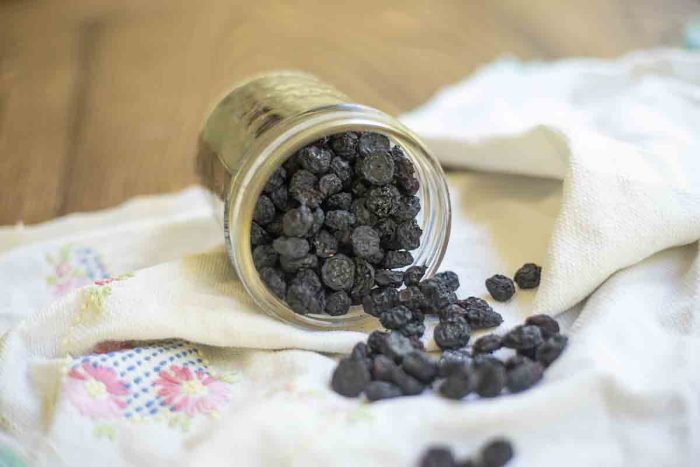
The Game-Changing Technique to Preserve Flavor and Texture
The game-changing technique lies in a simple yet effective step: blanching the blueberries before dehydrating them.
Blanching involves briefly immersing the blueberries in boiling water, followed by a quick plunge into an ice bath. This technique is known for its ability to preserve both flavor and texture, making it an essential step in the dehydration process.
When blueberries are blanched, their skins undergo a slight breakage, allowing for better moisture removal during dehydration without compromising the overall integrity of the fruit.
This means that while the blueberries become wonderfully firm and chewy, they still retain a burst of juiciness and their delicate flavor is preserved.
The blanching process also helps to preserve the vibrant color of the blueberries, ensuring that they not only taste great but also look visually appealing.
You can by-pass this step if you are using frozen berries.
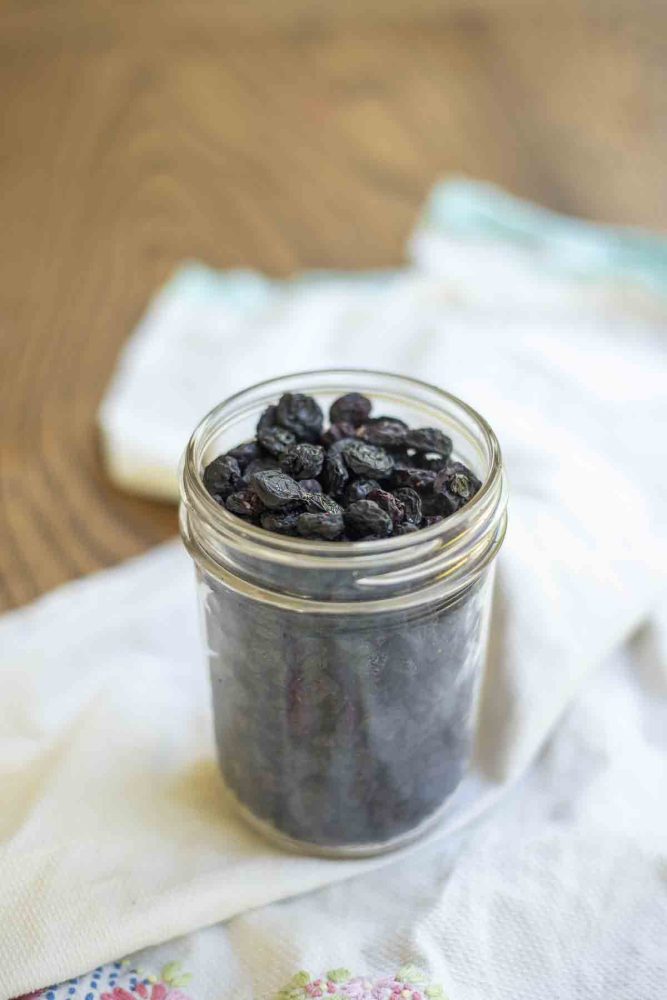
Tips and Tricks for Optimal Dehydration
- Dehydration time is based on the size of the blueberries. The bigger the blueberries the longer it will take to dehydrate them. Try to use blueberries that are the about the same size. Otherwise
- Evenly spread out the blueberries on your dehydrator trays. This allows for proper air circulation and ensures that all the berries dry uniformly. Avoid overcrowding the trays, as this can lead to slower and uneven dehydration.
- Adjusting the temperature and time settings on your dehydrator is also essential. Blueberries typically require a low temperature and longer drying time to retain their vibrant color and flavor.
- To further enhance the flavor of your dehydrated blueberries, consider adding a sprinkle of lemon juice or a light dusting of sugar before dehydrating.
- Proper storage is crucial for maintaining the quality of your dehydrated blueberries. Once they are fully dried, allow them to cool completely before transferring them to an airtight container or resealable bags. Store them in a cool, dark place to extend their shelf life and prevent any moisture from seeping in.
- One downfall of dehydrated foods is that the hot air decreases the vitamin c content and some other vitamins and minerals, but it is still a great healthy snack.
The links in this post contain affiliate links and I will receive a small commission if you make a purchase after clicking on my link. See the full disclosure here.
Tools you may need:
Food dehydrator: I use this one. I love it since it is all stainless steel without any plastic. Many people I know have and love the excalibur dehydrators.
Slotted spoon or fine mesh strainer
Pot
Storage container: I like to use a mason jar. Mylar bags work for long term storage. A plastic bag will also work for shorter term storage, but they tend to allow air through.
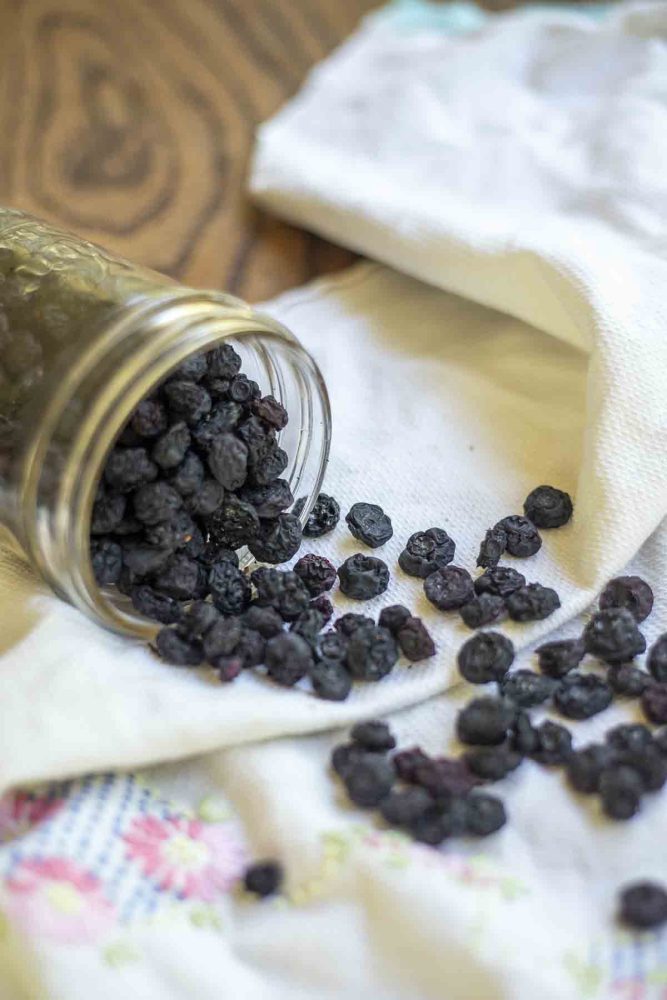
How To Dehydrate Blueberries
Wash the berries under cool running water. This step is crucial to remove any dirt, debris, or pesticide residue that may be present on the surface of the fruit.
Be gentle during this process to avoid damaging the delicate berries.
Blanch the blueberries

Place blueberries in a pot of boiling water and boil for about 30 seconds.
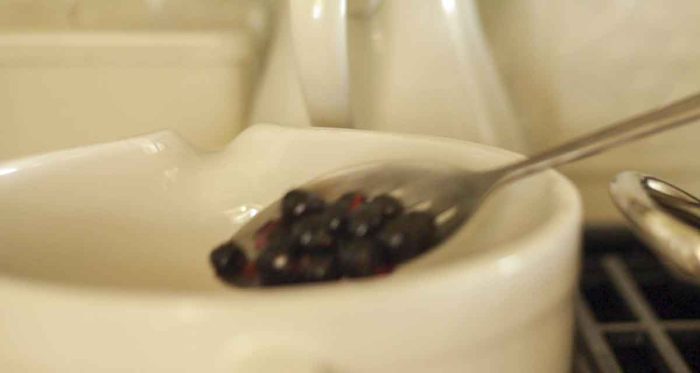
Transfer to ice water (or really cold water).
You have the option to leave them whole or slice them in half, depending on your preference. Sliced blueberries will dehydrate faster and more evenly, while whole blueberries may retain more of their natural shape and size.

Spread the blueberries out in a single layer on a dehydrator tray or a lined cookie sheet. Make sure the berries are evenly spaced and not touching each other, as this will promote even airflow and prevent them from sticking together during the drying process.
Save This Recipe
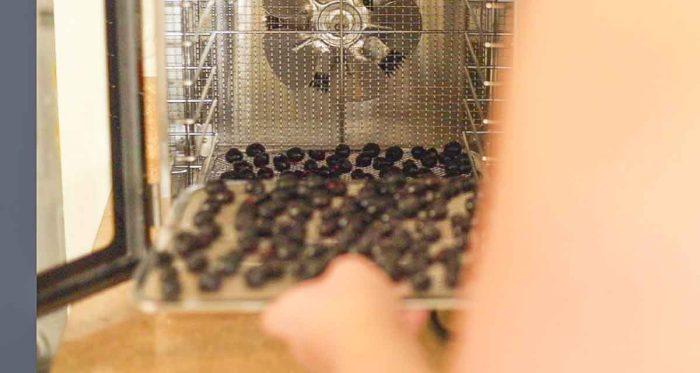
Set your dehydrator to a low temperature, typically around 135°F (57°C), and let the blueberries dry for an extended period of time.
The dehydration time can vary depending on the moisture content and the size of the blueberries, but it usually takes between 8 to 18 hours. Keep an eye on them and rotate the trays occasionally to ensure even drying.
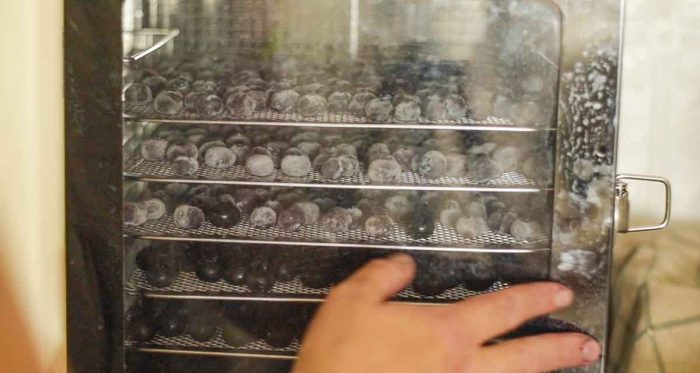
The blueberries are ready when they are shriveled and have a leathery texture. They should not feel damp or sticky when touched. If you notice any signs of moisture, continue drying them until they reach the desired consistency.
Once the blueberries are fully dried, allow them to cool completely before transferring them to an airtight container or resealable bags. Proper storage is crucial for maintaining the quality of your dried blueberries.
Store them in a cool, dark place to extend their shelf life and prevent any moisture from seeping in. For longer term storage and some oxygen absorbers to the container.
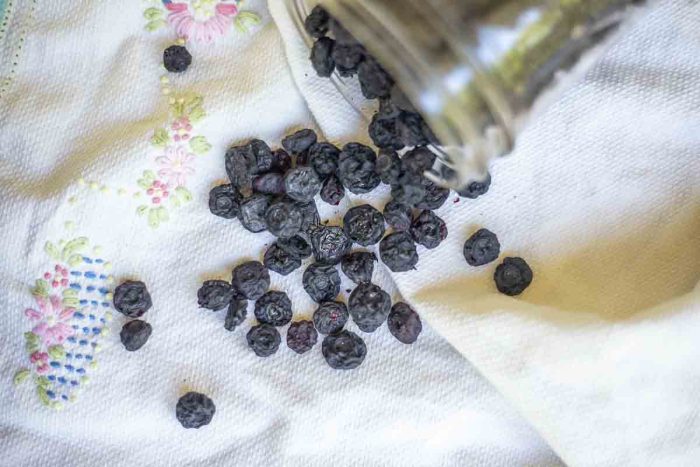
How to dehydrate blueberries in the oven:
Wash and dry your fresh blueberries.
Blanch them in boiling water for 30 seconds and then place them in a bowl of ice water for another 30 seconds.
Set the oven to the lowest temperature. Usually around 135-200 degrees f.
Place the blueberries evenly on a baking sheet lined with parchment paper or on a silicone mat.
Bake for 6-12 hours. Continue checking to make sure they are completely dry before removing from the oven.
Allow to cool completely.
How To Dehydrate Frozen Blueberries:
Place the blueberries straight from the freezer to the dehydrator racks, no need to blanch first.
Dehydrate until completely dry, about 8-18 hours.
Storage
Once the blueberries are fully dried, it’s important to focus on proper storage to maintain the exceptional quality of your dehydrated berries.
Let the dried blueberries cool completely before being transferred to an airtight container or resealable bags. This step allows them to reach room temperature and ensures that no residual moisture remains.
Choose a cool, dark place away from direct sunlight, as exposure to light can degrade the quality and flavor of the berries over time.
Optimal storage conditions will help retain their vibrant color and preserve their sweet taste for months to come.
Moisture is the enemy when it comes to dehydrated fruits, as it can quickly lead to spoilage. As you transfer the blueberries into their storage containers, make sure they are completely dry to prevent any moisture from seeping in.
Any hint of moisture can cause the berries to become soft and prone to mold growth, ultimately compromising their quality.
To maximize the shelf life of your dehydrated blueberries, it’s essential to seal them tightly in an airtight container or resealable bags. For long term storage add an oxygen absorber.
How To Use Dehydrated Blueberries
- Rehydrate the berries: Rehydrate them in hot water before adding them to your favorite recipes. Simply soak the berries in warm water for a few minutes until they become plump and juicy once again. They can be used in anything from muffins and pancakes to salads and smoothies. Their burst of flavor will add a delightful twist to any dish.
- If you prefer to keep the blueberries dehydrated, they make a fantastic addition to
- Add to granola and trail mixes
- Sprinkle them over yogurt
- Stand-alone snack for a burst of fruity goodness.
- Add to oatmeal
- Granola bars
- Create blueberry powder by throwing them in the blender or food processor and process until a fine powder is created. This is a great way to naturally color yogurt or frosting.
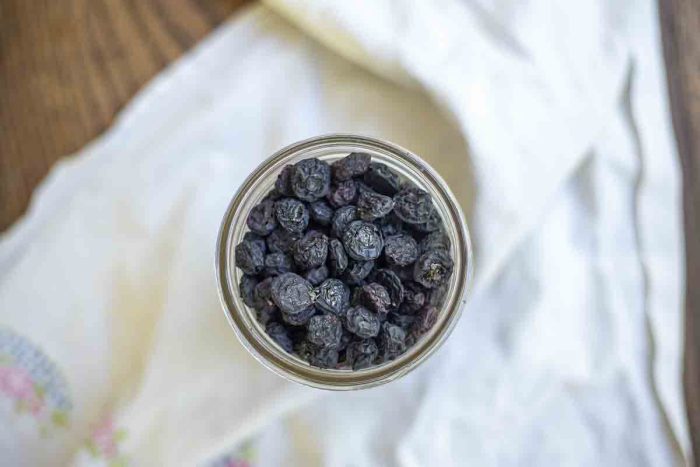
FAQ:
How long does it take to dehydrate blueberries?
The drying time for blueberries can vary depending on several factors, including the size of the berries and the moisture content. On average, it takes about 8 to 18 hours to dehydrate blueberries at a temperature of 135°F (57°C). However, it’s important to keep an eye on them and check for doneness by ensuring they are leathery and slightly shriveled.
Should I wash blueberries before dehydrating them?
Yes, it is recommended to wash blueberries before dehydrating them. Rinse them gently under cold water, removing any stems or leaves. Pat them dry with a paper towel before placing them on the dehydrator trays. This ensures that you remove any dirt or residues that might be present on the berries.
Can I dehydrate frozen blueberries?
Absolutely! Dehydrating frozen blueberries is a convenient option, especially when fresh blueberries are out of season. Simply place them straight from the freezer to the dehydrator trays. However, keep in mind that frozen berries might take slightly longer to dehydrate compared to fresh ones.
How should I store dehydrated blueberries?
To maintain the freshness and flavor of your dehydrated blueberries, store them in an airtight container. Mason jars or resealable bags work well for this purpose.
Keep the container in a cool, dry place away from direct sunlight. When stored properly, dehydrated blueberries can last for several months.
Can I rehydrate dehydrated blueberries?
Absolutely! Dehydrated blueberries can be rehydrated by soaking them in water or any liquid of your choice. This is particularly useful when you want to use them in recipes that require a softer texture, such as pies or compotes. Simply cover the berries with liquid and let them soak for a few minutes until they plump up.
How long will dehydrated blueberries last?
Dry fresh blueberries will last 6-12 months if stored in an air-tight container in cool, dark place.
Do you have to blanch blueberries before dehydrating?
Technically no, but they dehydrate better. The flavor and texture will be better.
Find More Of My Favorite Preserving Recipes:
- How To Dehydrate Strawberries
- 30+ Ways To Preserve Strawberries
- How To Freeze Blueberries
- Preserving Tomatoes Without Canning
- How to Freeze Zucchini
Try this recipe and love it? Come back and give it 5 stars and pin it! Please and thank you.
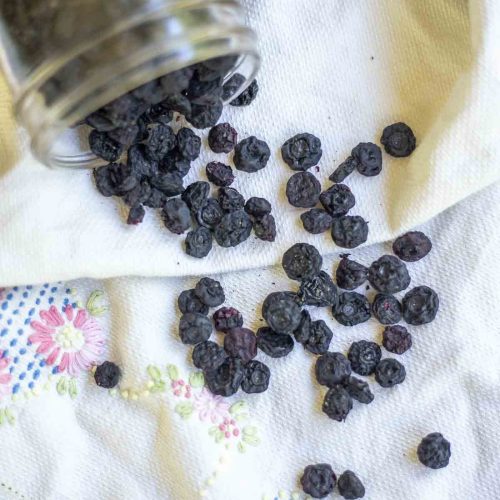
Dehydrated blueberries
Save This Recipe
Equipment
Ingredients
- 1-3 lbs blueberries fresh or frozen
Instructions
- Wash the berries under cool running water. Be gentle during this process to avoid damaging the delicate berries.
- Place blueberries in a pot of boiling water and boil for about 30 seconds. Transfer to ice water (or really cold water).
- You have the option to leave them whole or slice them in half, depending on your preference. Sliced blueberries will dehydrate faster and more evenly, while whole blueberries may retain more of their natural shape and size.
- Spread the blueberries out in a single layer on a dehydrator tray or a lined cookie sheet. Make sure the berries are evenly spaced and not touching each other, as this will promote even airflow and prevent them from sticking together during the drying process.
- Set your dehydrator to a low temperature, typically around 135°F (57°C), and let the blueberries dry for an extended period of time. The dehydration time can vary depending on the moisture content and the size of the blueberries, but it usually takes between 8 to 18 hours. Keep an eye on them and rotate the trays occasionally to ensure even drying.
- The blueberries are ready when they are shriveled and have a leathery texture. They should not feel damp or sticky when touched. If you notice any signs of moisture, continue drying them until they reach the desired consistency.
- Once the blueberries are fully dried, allow them to cool completely before transferring them to an airtight container or resealable bags.


Excellent article! Thanks for the drying tips!
Glad you enjoyed it!